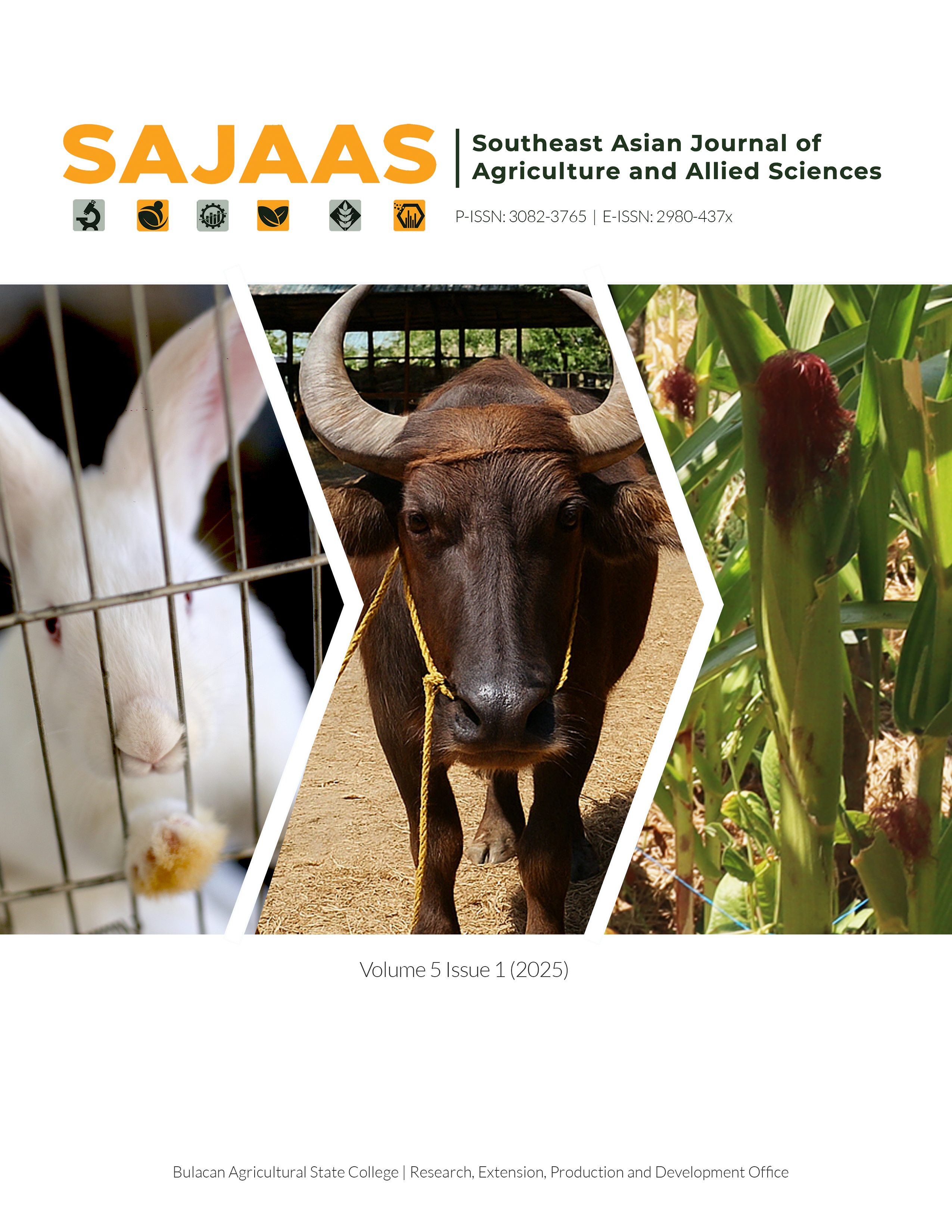Abstract
Assessing rabbit manure’s potential as a biofuel source for small-scale internal combustion engines was the primary objective of this study. The research utilized rabbit manure as feedstock, which was inoculated with carabao manure. A total of 60 kilograms of rabbit manure was subjected to treatment using a 1:1 water-to-manure ratio with a retention time of 25 days. Additionally, a microbial inoculant comprising 10% carabao manure was incorporated into the digestion process. The design consists of a split-type biogas digester with gasholder storage and a three-stage gas cleaning system, an internal combustion engine connected to a DC generator, and a simple lighting circuit. Findings indicated that the pH level recorded at 7.75 resulted in alkalinity which helped the biogas production by preventing the slurry from acidity. The total dissolved solids (TDS) were recorded at 3137 ppm, and it increased to 6980 ppm. For the performance evaluation in fueling the engine using biogas, the engine operated for 80 seconds and generates an average power of 31.66 watts.
References
Adewuyi, R. A., Ejiko, S. O., & Filani, O. A. (2019). Development of a House Hold Biogas Digester. International Journal of Modern Studies in Mechanical Engineering (IJMSME), 23-32.
Alejo, R. T., & Nicolas, H. J. (2021). Vermicompost Production using Rabbit (Oryctologus cuniculus) Manure. Psychology and Education, 5983-5986.
Al Seadi, T. (2008). Biogas Handbook. Sweden: Syddansk Universitet
Angelidaki, I., & Kougias, P. G. (2018). Biogas and its opportunities — A review. Frontiers of Environmental Science & Engineering,, 12(3), 1-12.
Astuti, N., Budiyono, & Retnaningsih Soeprobowati, T. (2013). Observation of temperature and pH during biogas production from water hyacinth and cow manure. An International Journal on Waste Technology, 22-25.
Bai, K., & Kumar, V. (2005). Plastic biodigesters – a systematic study. Energy for Sustainable Development, 40-50.
Bharate, R., Bhilare, N., Falcao, S., & Kunchumuthu, G. (2020). Portable Biogas Purification System using NAOH Water Scrubber, Iron Wool and Silica Gel. International Journal of Engineering Research & Technology (IJERT), 612-614.
Bora, B., Saha, U., Chatterjee, S., Veer, V. (2014). Effect of compression ratio on performance, combustion, and emission characteristics of a dual fuel diesel engine run on raw biogas.
Cheng, S., Huba, E.-M., Li, Z., & Mang, H.-P. (2013). A review of prefabricated biogas digesters in China. Renewable and Sustainable Energy Reviews, 739-747. doi:http://dx.doi.org/10.1016/j.rser.2013.08.030
Deng, L., Wang, W., & Yi, L. (2020). Biogas Technology. China: Springer Nature Singapore Pte Ltd. doi:https://doi.org/10.1007/978-981-15-4940-3
Divya, Gopinath, & Merlin Christy. (2014). A Review on Trends issues and Prospects for Biogas Production in Developing Countries. International Research Journal of Environment Sciences, 3(1), 62-69. Retrieved from http://www.isca.me/
Ferrer, I., Ponsa, S., Vazquez, F., & Font, X. (2008). Increasing biogas production by thermal (70◦C) sludge pre-treatment prior to thermophilic anaerobic digestion. Biochemical Engineering Journal, 186-192.
Gerardi, M. H. (2003). The Microbiology of Anaerobic Digesters. USA: John Wiley & Sons, Inc., Hoboken, New Jersey.
Hernandez, N. M., & Villanueva, E. P. (2017). Production, Purification and Utilization of Biogas as Fuel For Internal Combustion Engine. Engineering International Conference (EIC2017) (pp. 020009-1–020009). Iligan City: AIP Publishing.
IRENA. (2016). Measuring Small-scale Biogas Capacity and Production. Abu Dhabi: International Renewable Energy Agency (IRENA).
Kangle, K., & Kore, S. (2014). Recent Trends in Anaerobic Codigestion: A Review. Universal Journal of Environmental Research and Technology, 210-219.
Kukoyi, T. O., Muzenda, E., Akinlabi, E. T., Mashamba, A., Mbohwa, C., Mahlasti, T. (2015). Biogas Use as Fuel in Spark Ignition Engines, Faculty of Engineering and the Built Environment, University of Johannesburg, South Africa.,
Liangwei, D., Song , L., Xiaodong, P., Yong, Y., & Zhiyong, W. (2010). Biogas production potential and characteristics of manure of sheep, duck and rabbit under anaerobic digestion. 农 业 工 程 学 报, 277-281.
Lloyd, S., & Nakamura, T., (2022). Public Perception of Renewable Energy in the Philippines. Sustainability, 14(16), 9906. https://doi.org/10.3390/su14169906
Mattocks, R. (1984.). Understanding Biogas Generation.
Perez, A. C., Odales-Bernal, L., Lopez-Davila, E., Jimenez, J., (2021). Biomethane potential from herbivorous animal’s manure: Cuban case study. Journal of Material Cycles and Waste Management. Springer Japan - https://doi.org/10.1007/s10163-021-01220-9
Philippine Agricultural and Engineering Standards – 413 (2001). Agricultural Structures - Biogas Plant
Sarono, Ono Suparno, S., and, Hasanudin, U., (2016). The performance of biogas production from POME at different temperatures. International Journal of Technology (2016) 8: 1413-1421 - ISSN 2086-9614. https://doi.org/10.14716/ijtech.v7i8.6896
Tambong, A. I. (1992). Biogas Plant Design.
Zwain , H. M., Alzubaidi, S. A., Kheudhier, Z. A., & Irvan , D. (2019). Effect of Temperature on Compartmental Profile of Solid Content in a Modified Anaerobic Inclining-Baffled Reactor Treating Recycled Paper Mill Effluent. AIP Conference Proceedings 2124, (pp. 030003-1-9). doi:https://doi.org/10.1063/1.5117125

This work is licensed under a Creative Commons Attribution-NonCommercial-ShareAlike 4.0 International License.
Copyright (c) 2025 Southeast Asian Journal of Agriculture and Allied Sciences

